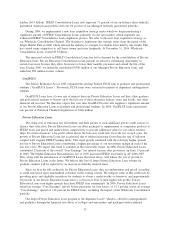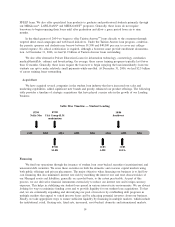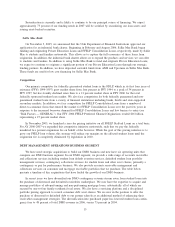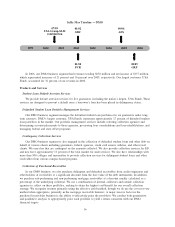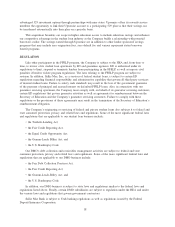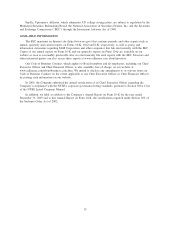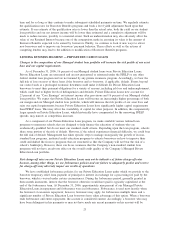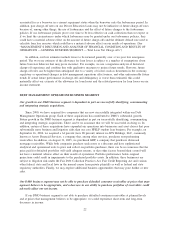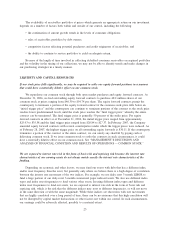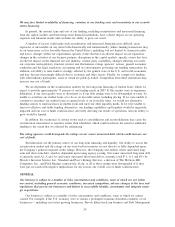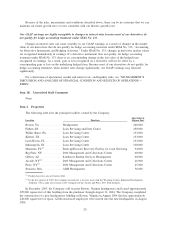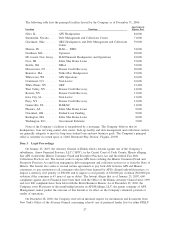Sallie Mae 2006 Annual Report Download - page 22
Download and view the complete annual report
Please find page 22 of the 2006 Sallie Mae annual report below. You can navigate through the pages in the report by either clicking on the pages listed below, or by using the keyword search tool below to find specific information within the annual report.time and for so long as they continue to make subsequent scheduled payments on time. We regularly estimate
the qualification rates for Borrower Benefits programs and book a level yield adjustment based upon that
estimate. If our estimate of the qualification rates is lower than the actual rates, both the yield on our student
loan portfolio and our net interest income will be lower than estimated and a cumulative adjustment will be
made to reduce income, possibly to a material extent. Such an underestimation may also adversely affect the
value of our Retained Interest because one of the assumptions made in assessing its value is the amount of
Borrower Benefits expected to be earned by borrowers. Finally, we continue to look at new ways to attract
new borrowers and to improve our borrowers’ payment behavior. These efforts as well as the actions of
competing lenders may lead to the addition or modification of Borrower Benefits programs.
LENDING BUSINESS SEGMENT — PRIVATE EDUCATION LOANS
Changes in the composition of our Managed student loan portfolio will increase the risk profile of our asset
base and our capital requirements.
As of December 31, 2006, 16 percent of our Managed student loans were Private Education Loans.
Private Education Loans are unsecured and are not guaranteed or reinsured under the FFELP or any other
federal student loan program and are not insured by any private insurance program. Accordingly, we bear the
full risk of loss on most of these loans if the borrower and co-borrower, if applicable, default. Events beyond
our control such as a prolonged economic downturn could make it difficult for Private Education Loan
borrowers to meet their payment obligations for a variety of reasons, including job loss and underemployment,
which could lead to higher levels of delinquencies and defaults. Private Education Loans now account for
23 percent of our “Core Earnings” net interest income after provisions and 16 percent of our Managed student
loan portfolio. We expect that Private Education Loans will become an increasingly higher percentage of both
our margin and our Managed student loan portfolio, which will increase the risk profile of our asset base and
raise our capital requirements because Private Education Loans have significantly higher capital requirements
than FFELP loans. This may affect the availability of capital for other purposes. In addition, the comparatively
larger spreads on Private Education Loans, which historically have compensated for the narrowing FFELP
spreads, may narrow as competition increases.
As a component of our Private Education Loan program, we make available various tailored loan
programs to numerous schools that are designed to help finance the education of students who are
academically qualified but do not meet our standard credit criteria. Depending upon the loan program, schools
share some portion of the risk of default. However, if the school experiences financial difficulty, we could bear
the full risk of default. Management has taken specific steps to manage strategically the growth of its non-
standard loan programs, instituted credit education programs to educate borrowers on how to improve their
credit and shifted the focus to programs that are structured so that the Company will not bear the risk of a
school’s bankruptcy. However, there can be no assurance that the Company’s non-standard student loan
programs will not have an adverse effect on the overall credit quality of the Company’s Managed Private
Education Loan portfolio.
Past charge-off rates on our Private Education Loans may not be indicative of future charge-off rates
because, among other things, we use forbearance policies and our failure to adequately predict and reserve
for charge-offs may adversely impact our results of operations.
We have established forbearance policies for our Private Education Loans under which we provide to the
borrower temporary relief from payment of principal or interest in exchange for a processing fee paid by the
borrower, which is waived under certain circumstances. During the forbearance period, generally granted in
three-month increments, interest that the borrower otherwise would have paid is typically capitalized at the
end of the forbearance term. At December 31, 2006, approximately nine percent of our Managed Private
Education Loans in repayment and forbearance were in forbearance. Forbearance is used most heavily when
the borrower’s loan enters repayment; however, borrowers may apply for forbearance multiple times and a
significant number of Private Education Loan borrowers have taken advantage of this option. When a borrower
ends forbearance and enters repayment, the account is considered current. Accordingly, a borrower who may
have been delinquent in his payments or may not have made any recent payments on his account will be
21




